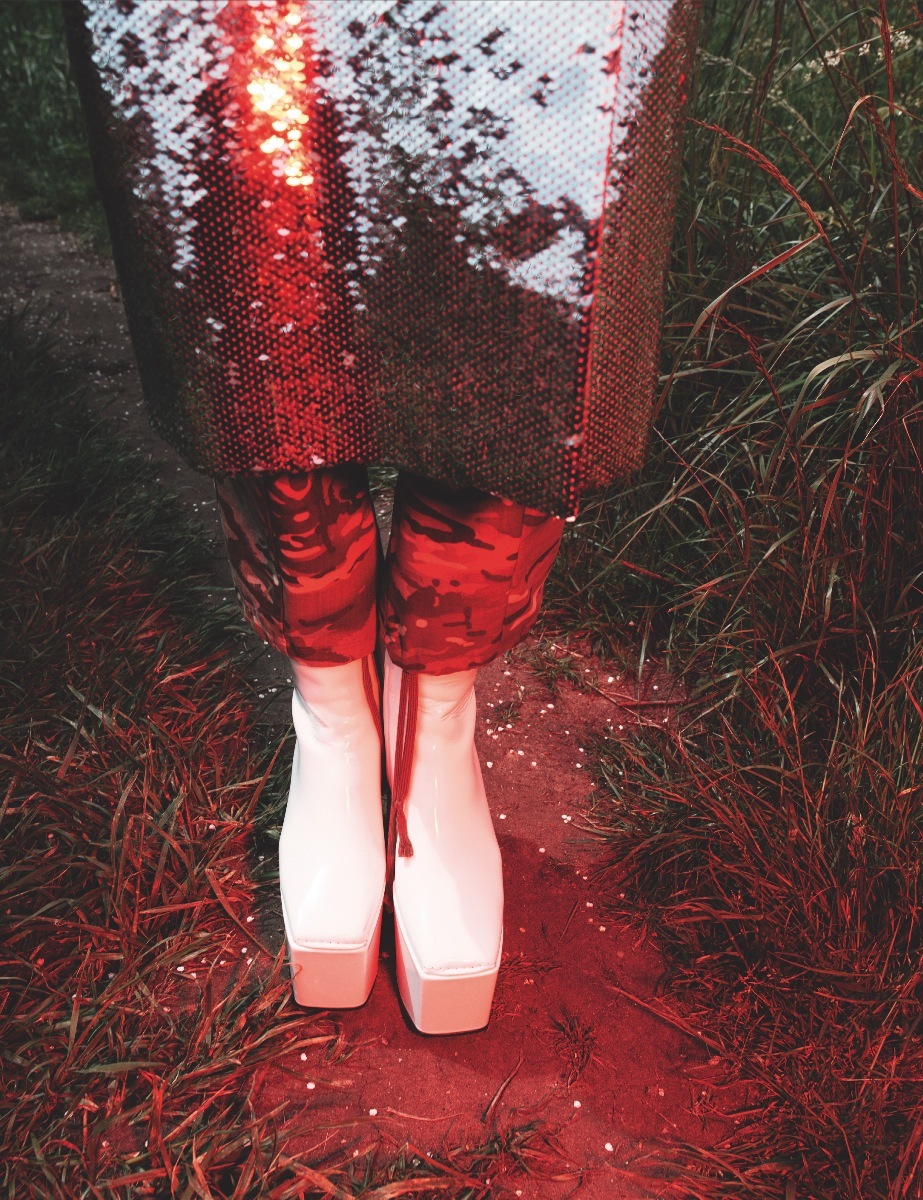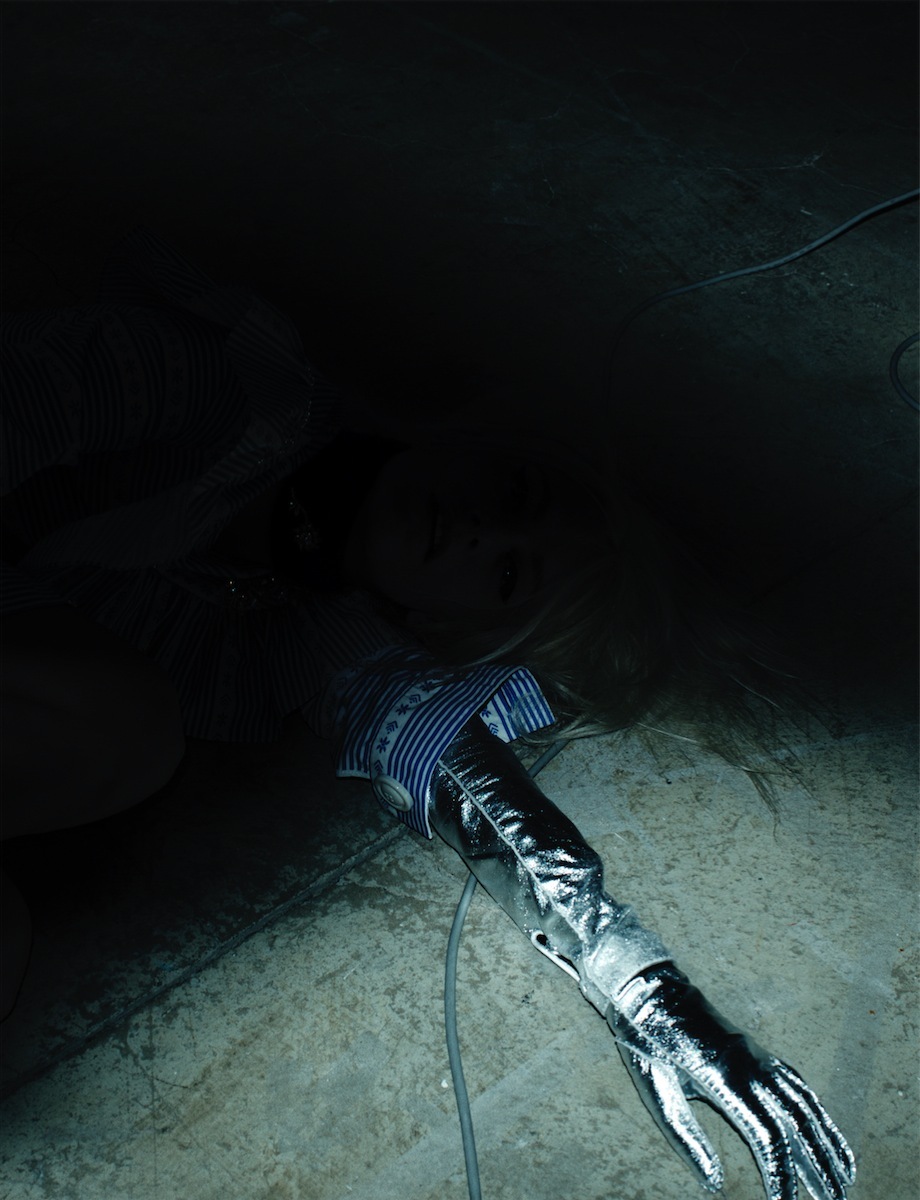Willy Vanderperre arrives at Red Hook Labs — a gallery, production studio, and educational space in South Brooklyn where the Belgian photographer is opening his first-ever New York show on Wednesday — less than 10 minutes after I do. I first see his navy, structured shorts from a distance, and assume they were designed by Raf Simons, Vanderperre’s close friend and cherished collaborator of over 20 years. Upon closer inspection, I discover the shorts are actually Dickies, a classic American workwear brand available at both Dover Street Market and Kmart. When he’s in town, Vanderperre gets his for $24 at Dave’s, a family-operated workwear nut’s heaven on Sixth Avenue in Chelsea. Despite creating iconic imagery for and with some of the fashion industry’s most beloved labels — Vetements, Prada, and nearly everything Simons touches — he still believes, “Dickies is the best brand in the world.”
Raised in Flanders, the Belgian bible belt, a teen Vanderperre split for Antwerp, where he studied Fashion Design at the storied Royal Academy of Fine Arts, before switching to its photography program. It was there he met Simons, stylist Olivier Rizzo, and makeup artist Peter Philips. Together, the team has created not only some of contemporary fashion’s most iconic images, but developed an emotional language rooted in the experiences of adolescent subculture and self-discovery. And so I bring up Vanderperre’s shorts to make a point: he’s democratic. Though the Red Hook exhibition’s opening night party is private, Vanderperre is adamant that his work should be made available to those it’s inspired by and speaks to: young people.
In addition to traditional prints of his images — which are both archival and never before seen — the show will also feature pins, patches, t-shirts, stickers, and even temporary tattoos, all produced in limited-edition runs. “Everybody wants to have a piece of art, a picture or an image by a photographer that you like,” Vanderperre explains. “So instead of doing just a regular show with only beautiful prints all over, let’s also work around things that are attainable and accessible for those kids.”

Do you like coming to New York?
Of course. In a way, it feels like coming home. When you drive and see the skyline, you know it from your earliest childhood memories, even if you’ve never been here. Every corner of the street you sense, even if it’s not the same corner. You feel like, ‘I’ve known that corner already, my entire life.’ The familiarity comes instantly; it’s like a filmic scene, or it’s a picture by a photographer that you know. It’s comforting that it’s recognizable. Yesterday I was walking by construction work at night — it’s so rare, because in Belgium, one would never see it at night. It’s beautiful.
Are there any places you like to go — stores or galleries — while you’re here?
I think New York is, for the arts, the best in the world. And now that summer’s over, shows are starting back up, and it’s really exciting. In a weird way, the shopping experience for me is not so important. I like to go to Dave’s —
I was just about to ask if you’ve ever been to Dave’s.
Oh, of course. I have to stock up my Dickies!
I hear you; they might as well make my paycheck out to Dave. Will you be in New York more now that Raf is at Calvin?
I am already here a lot, and he’s one of my closest friends, so of course I’m going to try to visit him more. It’s weird how distance is; we are never really in the same city for such an extent of time. There was Jil, Dior, and now Calvin. You text and you call and all that stuff, but now you even do it more because the distances are much further. Whereas when he was in Paris — because it’s only a two hour drive — you could spend two weeks without seeing or even talking to each other, because in your head, he’s super close by. Now he’s far away, so you’re way more busy with calling each other and texting each other. It’s almost like an enrichment for your relationship, being so far away from each other.

This is your first New York show. Let’s talk about its starting points.
Sometimes, things go organically without any effort, and this one came about similarly. My obsession still stays: youth, youth culture, and young people. Jimmy [Moffat, founder of Red Hook Labs] and I go a little bit back because he co-founded the agency I’m from. I came here and he started to tell the story about Red Hook Labs, and the thought process behind it. It’s similar to how I feel and think; when I was a teen, there was no Taschen. Well, there was, but not as extensive as it is now. You had to really save for a book that you wanted by an artist or a photographer you loved. My main focus — my main group that I’d like to inspire — is younger kids. So why would things be unattainable for them? That’s why I did 635, the Instagram book that was not so expensive to buy. It’s the same with this show, and that’s what Jimmy stands for, too — Red Hook Labs has photography courses and interacts with the community.
We were thinking about how to do the show, and I thought the show should play on that, because it’s also what I like. So we’re doing a lot of items; I call them items because it’s not merchandizing, there aren’t a gazillion of them. It is a badge, a sticker, a patch, a poster, a t-shirt, a bag, removable tattoos — all these items will be limited edition, hand signed, numbered with a certificate. You can buy your perfectly framed artwork, but you can also get a little badge. I wanted things to be attainable; it’s something that’s always on my mind.

You also did stickers for the Raf retrospective at 032c. At the time, you were talking about how stickers allow us to assemble our sense of self — things we love or identify with — and broadcast it to the world. But at the same time, it is a form of advertising.
Not only is it advertising, it’s very permanent. You put a sticker on something, a laptop, and it’s rare you’ll peel it off. It will be there until it’s chipped or faded away; I think it’s the weirdest permanent thing. I love stickers, I’m obsessed with them. So we’re doing the items and trying to make the show into more of an event. In the parking lot across the street, we’re going to have a giant screen and play a video — a music video I’ve directed for a Belgian band. Then, you enter through the 133 door, and this space will already be a party; DJ Clara is playing all night.
How did you make the edit of which images to include? Otherphotographers I’ve interviewed say it’s often a dialogue with Jimmy.
It was really nice because he was in Europe for a period of time and able to visit my studio. I’m pretty organized in my archive, so we looked at the archive and instinctively, almost, pulled pictures by emotion. We just threw them on the floor, and peeled them off again; then I added new and unseen work on top of them. I left it there for a while then, took away, added, picked off, added new work again. It becomes a new story that you tell; the nice thing about it is that some of the work is older, and it melts with the new work. You start to create updated representation of what your mindset is. It’s very much what I feel for the moment. I always search for an emotion, and I feel if you walk through it, it will be a nice journey. There’s a lot of fashion photography in there, a few i-D pictures, still lifes — all blended together. And we played with texture; some of it is really big.

With such an intuitive editing process, do you feel the emotion is characterizable in any way? Where do you feel the emotion sits?
I think everybody — with work, with music — you are trying to trying to give a reflection of the times we live in, or what you experience personally. So this is intuitive and organic, but at the end of the day, it becomes a story because it’s how you feel at the time. That’s how I exist, I feel: from obsession to obsession, of course, but also from emotion to emotion. You bring things together and then pull them back, and in a weird way, things get linked. The journey is what to present to people — work, music, image. An image can evoke or trigger an emotion, but it’s only in the eye of the beholder. If you listen to the most happy song in the world and you’re depressed, that song is torturous. You walk through show and get an idea of an emotion, but you transport that emotion and it talks back to you in whatever sense you want it to.
Willy Vanderperre, ‘prints, film, posters, and more’ will be on view to the public from September 15-25 at Red Hook Labs, more information here.
Credits
Text Emily Manning
Photography Willy Vanderperre
